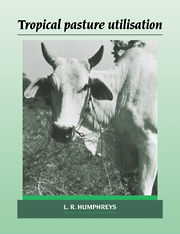Book contents
- Frontmatter
- Contents
- Acknowledgements
- List of abbreviations
- 1 Introduction
- 2 Pastures in tropical farming systems
- 3 Grazing and the environment for pasture growth
- 4 Effects of defoliation on the growth of tropical pastures
- 5 The modification of botanical composition by grazing: plant replacement and interference
- 6 The response of grazing animals to tropical pastures
- 7 Stocking rate and animal production
- 8 Continuity of forage supply: 1. The integration of different pastures
- 9 Continuity of forage supply: 2. Pasture conservation and supplementary feeding
- 10 Systems of rotational, deferred and mixed grazing
- 11 Conclusion
- References
- Index
5 - The modification of botanical composition by grazing: plant replacement and interference
Published online by Cambridge University Press: 23 September 2009
- Frontmatter
- Contents
- Acknowledgements
- List of abbreviations
- 1 Introduction
- 2 Pastures in tropical farming systems
- 3 Grazing and the environment for pasture growth
- 4 Effects of defoliation on the growth of tropical pastures
- 5 The modification of botanical composition by grazing: plant replacement and interference
- 6 The response of grazing animals to tropical pastures
- 7 Stocking rate and animal production
- 8 Continuity of forage supply: 1. The integration of different pastures
- 9 Continuity of forage supply: 2. Pasture conservation and supplementary feeding
- 10 Systems of rotational, deferred and mixed grazing
- 11 Conclusion
- References
- Index
Summary
Objectives of management
Grazing modifies the proportion of different plant species which occupy the sward. Systems of grazing may be directed to producing particular combinations of plants for specific purposes.
(i) One objective assumes that the dominance of the most productive plants leads to higher plant yields. Considerable activity is directed to the eradication or reduction of less productive species. However, the loss of yield associated with the occurrence of less productive plants in the sward may have been overstated, since vigorous plants growing next to less vigorous plants grown even more than if next to other vigorous plants (Smith & Alcock, 1985).
(ii) Management may be more legitimately directed to the promotion of plants of high nutritive value, to the control of unpalatable plants, which do not contribute to the feed ingested, or of toxic plants, which damage animal health.
(iii) A frequent objective is the control of the balance between grasses and legumes, so that growth, nitrogen accretion and the maintenance of nutritive value may be optimised.
(iv) Species composition, especially with respect to the content of sod-forming plants, bears on the resistance of the landscape to soil erosion and on the runoff characteristics of the sward.
[…]
- Type
- Chapter
- Information
- Tropical Pasture Utilisation , pp. 66 - 87Publisher: Cambridge University PressPrint publication year: 1991



